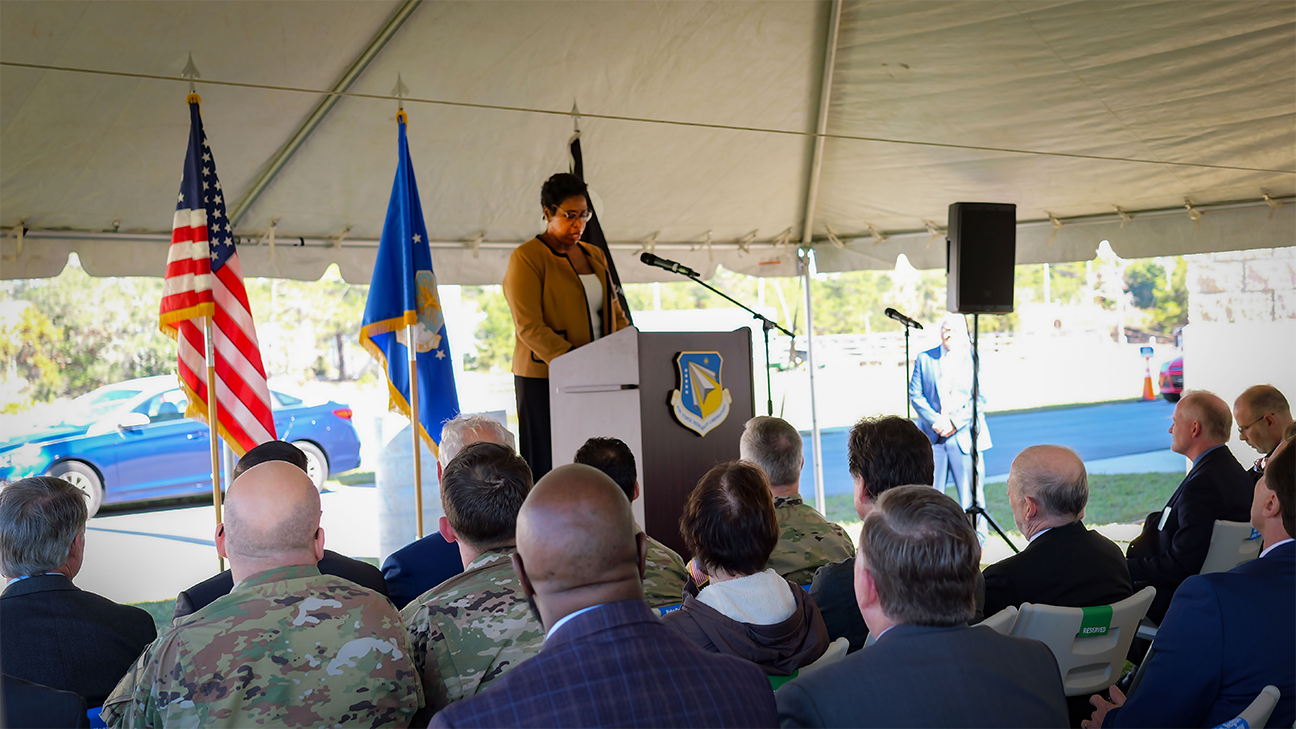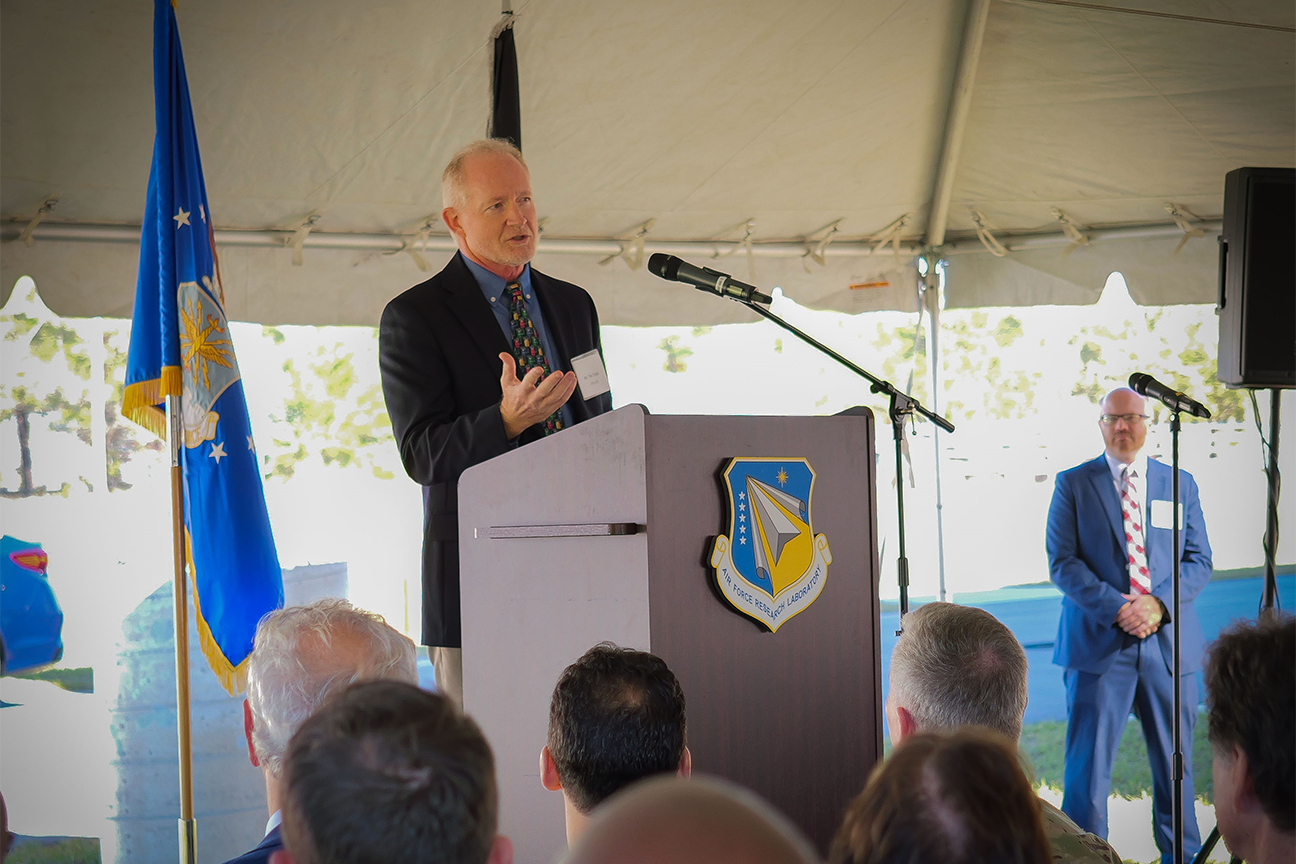AFRL reveals Advanced Munitions Technology Complex at Eglin Air Force Base
EGLIN AIR FORCE BASE, Fla. (AFRL) — The Air Force Research Laboratory, or AFRL, hosted a ribbon-cutting ceremony Dec. 15, 2022, for the lab’s new Advanced Munitions Technology Complex, or AMTC, at Eglin Air Force Base, Florida.
AFRL constructed the AMTC, a state-of-the-art complex, to ensure war-winning capabilities and support technologies today and into the future. In the end, the cost was approximately $165 million, not including the equipment that will later fill the buildings. The project provides unparalleled test capability and modernizes the 1960s high explosive infrastructure.

Dr. David Lambert, left, chief scientist, AFRL’s Munitions Directorate; and Dr. J. Jacob Morris, right, chief, Energetics Materials Branch, ordnance division at AFRL’s Munitions Directorate, assist Chief Master Sgt. James “Bill” Fitch, AFRL Command Chief, in a ribbon-cutting ceremony for the lab’s newly constructed Advanced Munitions Technology Complex, or AMTC, at Eglin Air Force Base, Florida, Dec. 15, 2022. This military construction project, worth approximately $165 million, provides new test capability and modernizes much of the outdated 1960s infrastructure. AFRL designed the AMTC as a modern, collaborative research space that gives scientists and engineers the ability to experiment with new explosive materials and integrate them into complex munition designs. (U.S. Air Force photo / Keith Lewis)

The Air Force Research Laboratory’s Munitions Directorate hosted a dedication and ribbon-cutting ceremony for the lab’s newly constructed Advanced Munitions Technology Complex, or AMTC, at Eglin Air Force Base, Florida, Dec. 15, 2022. This military construction project, worth approximately $165 million, provides new test capability and modernizes much of the outdated 1960s infrastructure. AFRL designed the AMTC as a modern, collaborative research space that gives scientists and engineers the ability to experiment with new explosive materials and integrate them into complex munition designs. (U.S. Air Force photo / Keith Lewis)
AFRL designed the critical National Defense facility as a modern, collaborative research space that allows scientists and engineers to experiment with new explosive materials and integrate them into complex munition designs more efficiently.
“[With this facility], researchers will now be able to conduct additional experiments,” said Segrid Harris, deputy director, Munitions Directorate, AFRL. “We’ll be able to enhance our science and our technology even further. Things that we did not have the capacity to do before; we will have the capacity to do now. And capacity is the key. Capacity allows you to go further, capacity allows you to accelerate, capacity allows you to change.”

Segrid Harris, deputy director of the Air Force Research Laboratory’s Munitions Directorate, delivers remarks at the directorate’s dedication and ribbon-cutting ceremony for the lab’s newly constructed Advanced Munitions Technology Complex, or AMTC, at Eglin Air Force Base, Florida, Dec. 15, 2022. This military construction project, worth approximately $165 million, provides new test capability and modernizes much of the outdated 1960s infrastructure. AFRL designed the AMTC as a modern, collaborative research space that gives scientists and engineers the ability to experiment with new explosive materials and integrate them into complex munition designs. (U.S. Air Force photo / Keith Lewis)
With the monumental task of designing and building such a unique facility ahead of them, committees were formed, and stakeholders were gathered.
Since stepping up in the division office in 2015, Tim Tobik, interim chief, Ordnance Division, Munitions Directorate, AFRL, said he has seen the changes as the facility has come to fruition. And with the project being a large military construction, or MILCON, project, Tobik said this was the opportunity of a lifetime.

Tim Tobik, interim chief of the ordnance division at the Air Force Research Laboratory’s Munitions Directorate, makes remarks at the directorate’s dedication and ribbon-cutting ceremony for the lab’s newly constructed Advanced Munitions Technology Complex, or AMTC, at Eglin Air Force Base, Florida, Dec. 15, 2022. This military construction project, worth approximately $165 million, provides new test capability and modernizes much of the outdated 1960s infrastructure. AFRL designed the AMTC as a modern, collaborative research space that gives scientists and engineers the ability to experiment with new explosive materials and integrate them into complex munition designs. (U.S. Air Force photo / Keith Lewis)
Before construction could begin, a design team began to view other state-of-the-art facilities and look at lessons learned.
After composing the right design, Tobik said the team had to begin construction that would meet “explosive approval for intentional detonation.”
“It was going to take a lot of effort, and we really had one chance to get it right,” he added.
The more formal process of the MILCON began, and key groups came together including Air Force Civil Engineering Command, Eglin civil engineering, Army Corps of Engineers, Eglin Corps of Engineers and many contractors.
And just like that, a team of 12 people quickly grew to about 5,500.
Tobik asked the audience to remember the Star-Spangled Banner lyrics, specifically the words “the rockets’ red glare, the bombs bursting in air.’”
“How cool is it that our national anthem has the exact item that these buildings are doing research for and making sure that we can continue to deliver that to the nation?” he asked.
Even though those words were written in 1814, Tobik said this facility will allow the nation to continue “to make sure those bombs do burst in air and that they deliver the right effects on the right targets at the right time, so that we all can enjoy the freedoms that we do.”
Dr. C. Michael Lindsay, technical adviser, Energetics Materials Branch, Munitions Directorate, AFRL, recounted his days as a post-doctoral researcher in 2005, when he worked with Allen B. Beach, who would work many late nights and bounce questions off Lindsay.

Dr. C. Michael Lindsay, technical adviser, Energetics Materials Branch, Ordnance Division, of the Air Force Research Laboratory’s Munitions Directorate, pays tribute to Allen B. Beach, for his role in making the dream of a new Advanced Munitions Technology Complex, or AMTC, a reality at AFRL’s Munitions Directorate, Eglin Air Force Base, Florida, Dec. 15, 2022. Lindsay gave credit to Beach, who died, stating that he was “instrumental in getting [this project] over the finish line.” (U.S. Air Force photo / Keith Lewis)
Lindsay gave credit to Beach, who died, stating that he was “instrumental in getting [this project] over the finish line.”
He said the vision for this facility began in 1965, with the goal of completing every aspect of explosive development, processing capabilities, characterization capabilities, detonation capabilities and assembling it in one location.
The team was able to help grow and evolve this goal, Lindsay said, while prioritizing advanced manufacturing methodologies, new advanced materials, safety systems as well as anticipating future environmental and regulatory burdens.
But the top priority, Lindsay said, was integrated science and technology, or S&T.
“That was our top priority, to be able to bring people together with different experiences, different viewpoints, different toolboxes,” he added.
The teams’ second priority, Lindsay said, was to “nurture through design, research or collaboration, bring people together because great things happen when you bring great people together.”
The facility was designed years ago to support fusion teams, he added, and it was important to bring people together.
As the buildings came together, Lindsay said he began to feel the pressure of what is next to come in gainfully employing people.
“It’s our obligation to bring this to life to make it effective to serve the needs of our warfighters today and of tomorrow,” he said. “We owe it to the taxpayers who have spent a tremendous amount of coin on these facilities. We owe it to the men and women who are going to put their lives in harm’s way to defend our freedoms. We owe it to our nation to provide it with the best technologies to defend itself.”
The AFTC is a national asset, Lindsay said.
“AFRL is not going to be able to put enough people in these buildings to bring them to life,” he added. “We need your help. These are our facilities. We’re going to be setting up partnerships. We’re going to set up scientist exchange programs [for] short term, midterm and long term.”
Lindsay said the hope is to see every branch of the U.S. military using this new facility.
With the understanding that everyone has a different perspective and set of “tools” that they bring to the table, he said it’s important to begin working together.
“We need to get working with industry from the beginning, so that we can transition into production into manufacturing as quickly as possible,” Lindsay said.
With the abundance of experience, Lindsay expects to see the work in this facility grow.
“Colleagues from the national laboratories, we need to expand on those programs where we interact with one another,” he said. “We are all moving in the Department of Defense to digital engineering to be able to decide and understand how systems age at the level of sophistication that previously were limited to nuclear weapons. We’re now applying that to our advanced conventional technologies.”
Transitioning that knowledge and growing it into capabilities that can be shared is another goal through this collaboration.
“This is one of those opportunities that we have to take advantage of as a team,” Lindsay added. “This organization has a history of doing amazing things.
About AFRL
The Air Force Research Laboratory is the primary scientific research and development center for the Department of the Air Force. AFRL plays an integral role in leading the discovery, development, and integration of affordable warfighting technologies for our air, space and cyberspace force. With a workforce of more than 11,500 across nine technology areas and 40 other operations across the globe, AFRL provides a diverse portfolio of science and technology ranging from fundamental to advanced research and technology development. For more information, visit: www.afresearchlab.com.
